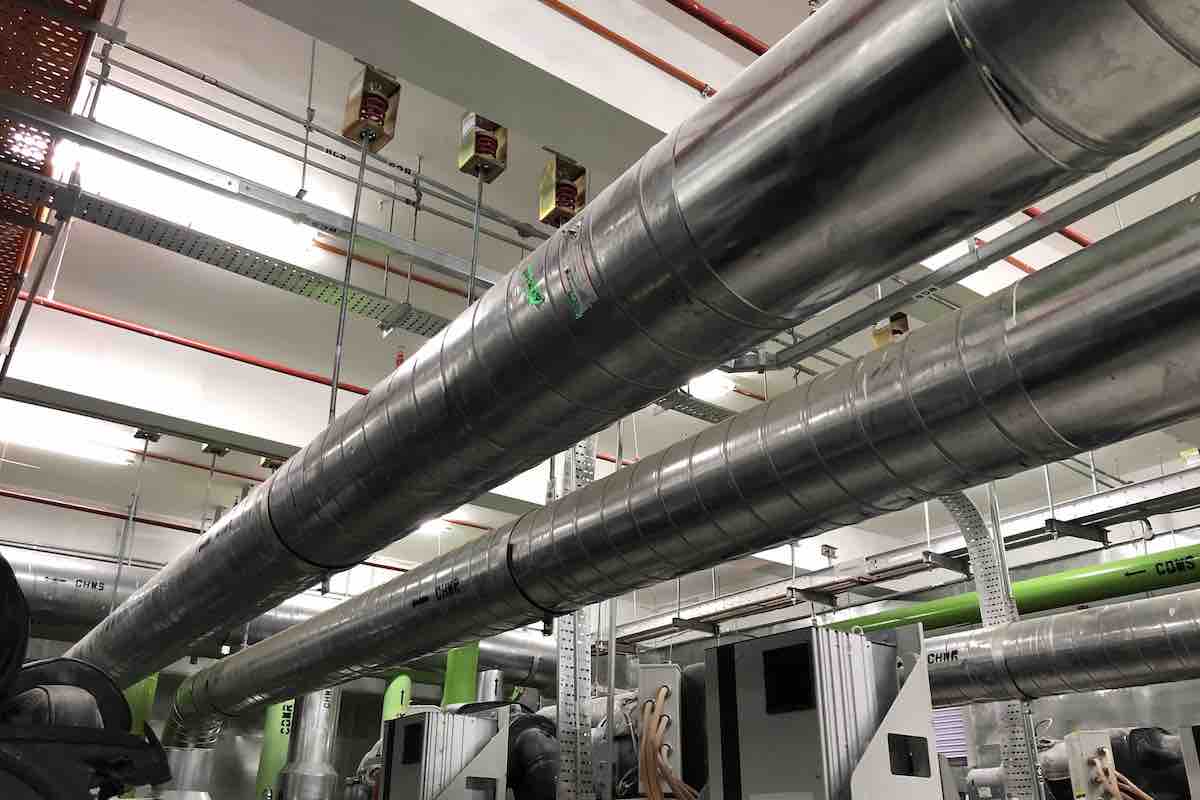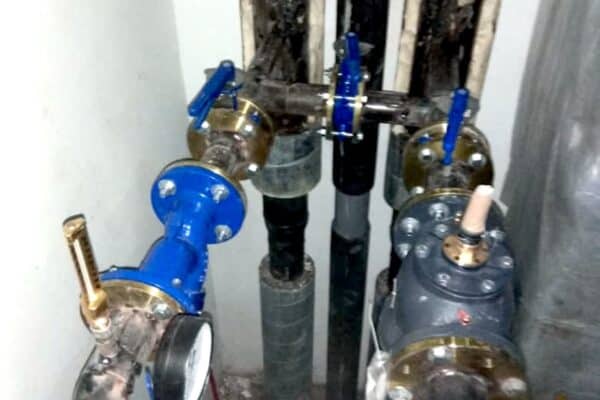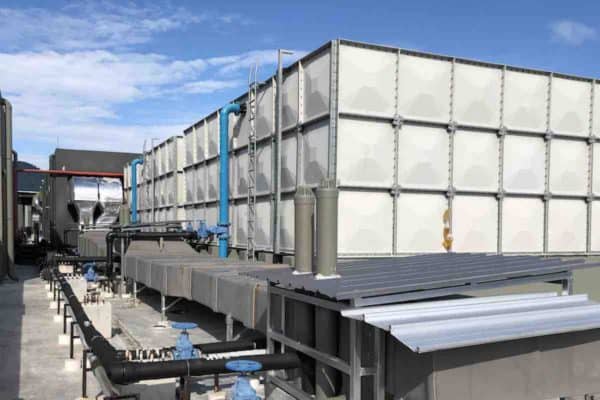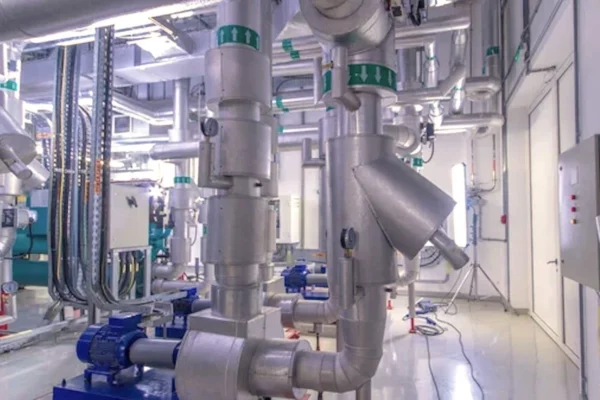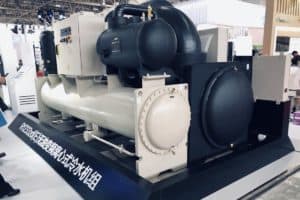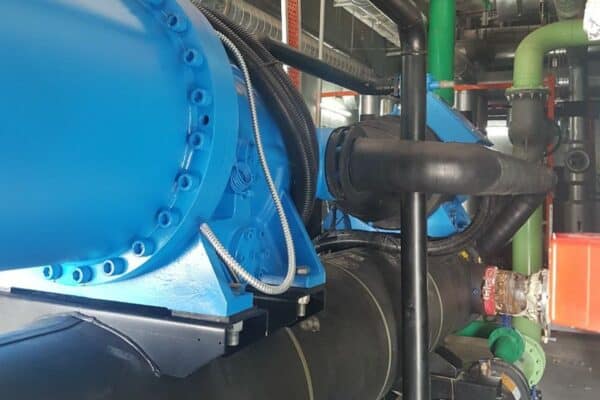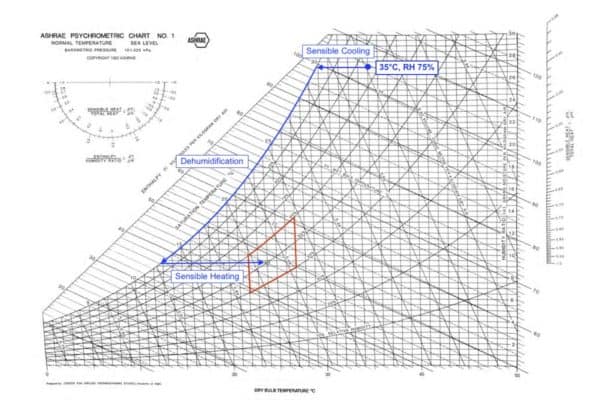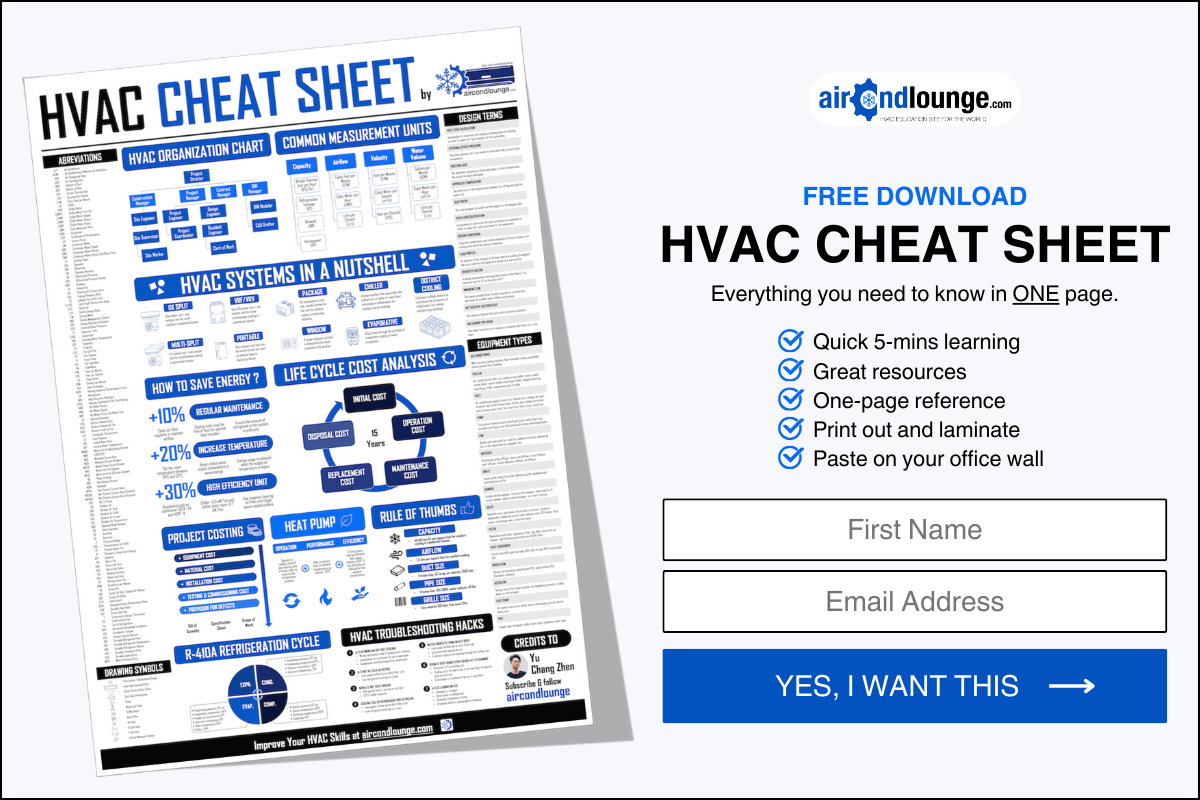Chilled Water Pipe Sizing Guide: Chart, Standard & Calculator
The size of the chilled water pipes used in a chilled water system directly affects the installation cost and the pumping cost of the system. In this post, I’ll share an example of how to size chilled water pipes and explain the criteria on which pipe sizing is based.
Generally, chilled water pipes are sized based on a velocity limit of 4 fps for 2″ pipe and below, and a friction loss limit of 4 ft per 100 ft for pipes over 2″. However, these limitations can be changed in favor of factors such as cost, noise, appearance and space availability.
| Pipe Size | Limitation |
|---|---|
| 2″ and below (50mm and below) | 4 fps (1.2 m/s) |
| Above 2″ (Above 50mm) | 4 ft per 100 ft (400 Pa/m) |
When sizing chilled water pipes, the primary concern is the water velocity. Too high or too low of water velocity is not desirable and a minimum velocity is needed for optimal performance.
How to Size Chilled Water Pipe?
There are several tools we can use to size chilled water pipes. One easily accessible tool is the friction loss chart, commonly from either ASHRAE or Carrier.
Both the ASHRAE and Carrier charts are derived from the Darcy-Weisbach or the Hazen-William equation. We can either use the equation which is more complex or simply use the chart.
In the following, I’ll show you how to use each friction loss chart.
ASHRAE Friction Loss Chart
The ASHRAE friction loss chart can be found in the ASHRAE Handbook of Fundamentals. Or, you can download the one with design criteria from the below link:
- ASHRAE Sch40 Pipe Friction Loss Chart (Download Here)
Below is the ASHRAE friction loss chart which I’ve added the 3 steps to find the pipe size.
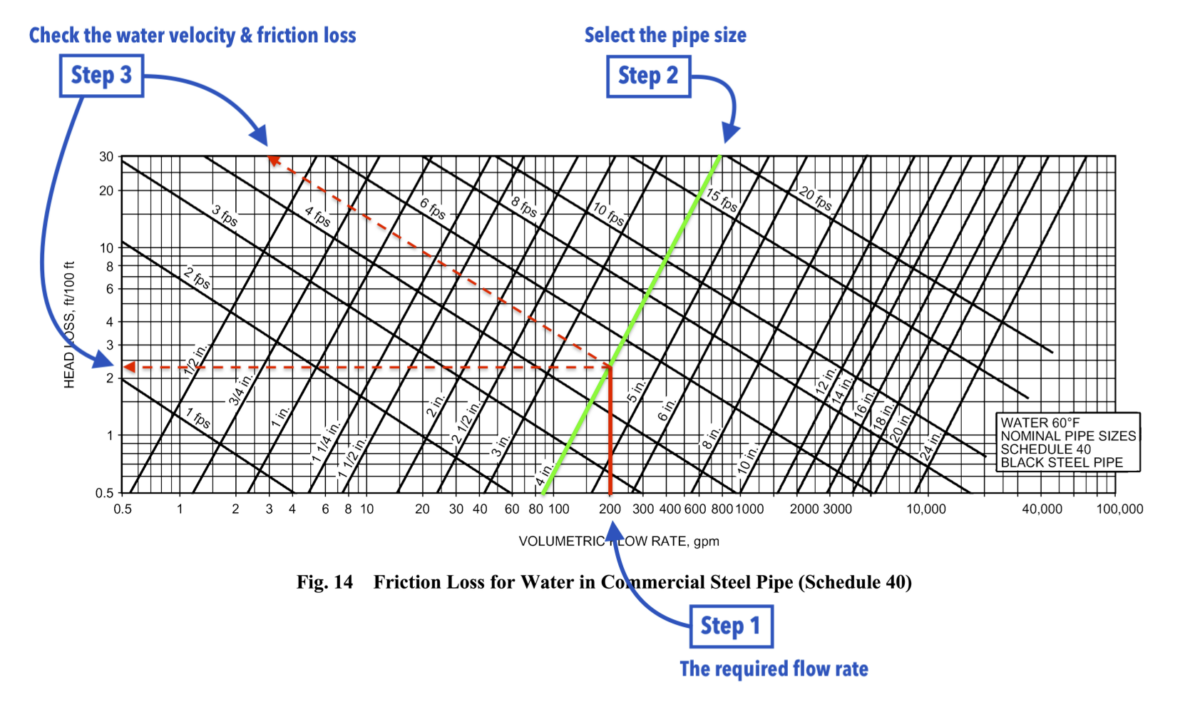
Sizing chilled water pipes using the ASHRAE friction loss chart involves 3 simple steps:
- Draw the required flow rate.
- Select the pipe size.
- Check the water velocity and friction loss.
In the case of the above example, the required chilled water flow rate is 200 gpm. Given that a 4″ pipe is selected, the resulting water velocity is 5 fps and friction loss is about 2.3 ft per 100 ft.
Based on ASHRAE’s recommendation, pipes above 2″ should have a friction loss below 4 ft per 100 ft.
Therefore, the above sizing is acceptable and the 4″ pipe is suitable for 200 gpm.
Carrier Friction Loss Chart
The Carrier friction loss chart can be found in the Carrier Pipe Design Manual. Also, you can download the one with design criteria from the below link:
- Carrier Sch40 Pipe Friction Loss Chart (Download Here)
For the Carrier friction loss chart, the steps to size chilled water pipe are the same. See the below chart.
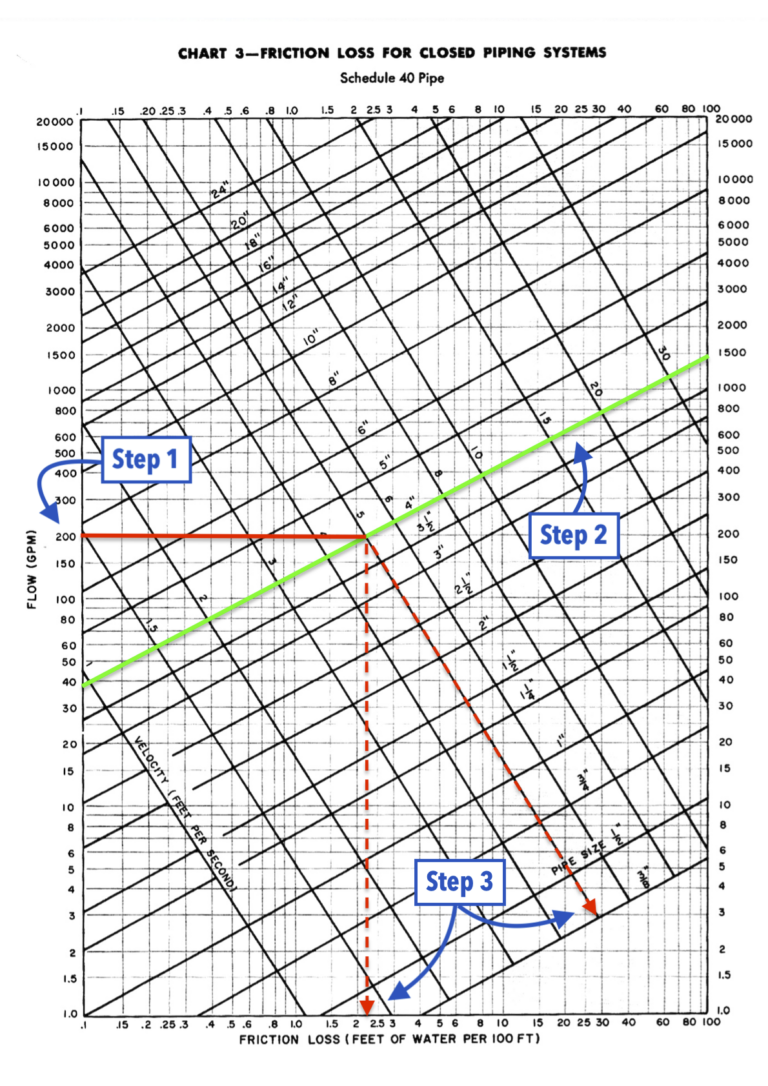
Although both charts are oriented differently, they produce the same result. Personally, I find the Carrier one easier to read and use.
It is easy to just follow the rule of thumb (velocity 4 fps, friction loss 4 ft per 100 ft) to size chilled water pipes. But, what are the underlying principles? Can we make changes? If so, what are the upper and lower limits?
Therefore, it’s important that we understand these limitations and how they affect the system.
Chilled Water Pipe Sizing Criteria
Chilled water pipes are sized based on a certain limit of water velocity and friction loss. These limitations are the criteria we set to ensure good performance of our chilled water system.
Water Velocity
As mentioned earlier in this post, water velocity is the primary concern when sizing a chilled water pipe. In general, there are 3 factors to consider:
- System efficiency
- Pipe lifespan
- Noise
The heat transfer efficiency of chilled water fan coil unit drops when there are air bubbles in the chilled water. To eliminate air bubbles, chilled water systems typically use air-vent valves or an air separation unit (or both).
However, if the water velocity is too low, the chilled water won’t be able to carry the air bubbles to the air-vent valves (located at the highest point) or the air separation unit (could be in the basement).
Therefore, the minimum water velocity for chilled water pipe sizing is 2 fps (0.6 m/s) as recommended by ASHRAE.
While too low of water velocity can hurt the efficiency of the system, too high of water velocity is not desirable either.
As water moves through pipes, air bubbles (some are inevitable), sand and other solid matter will gradually erode the pipe. ASHRAE noted that erosion is not significant at below 10 fps.
Nonetheless, water velocity is inversely proportional to the lifespan of the pipe (in terms of operating hour) as provided by Carrier below.
| Normal Operation (hr/year) | Water Velocity (fps) |
|---|---|
| 1500 | 15 |
| 2000 | 14 |
| 3000 | 13 |
| 4000 | 12 |
| 6000 | 10 |
| 8000 | 8 |
In any case, the maximum water velocity for chilled water pipe sizing is 15 fps (4.6 m/s) as recommended by Carrier.
Another factor to consider when deciding what water velocity to use is noise.
When moving through straight pipes, high water velocity (even more than 15 fps) is not necessarily the cause of noise. While what actually can cause noise in pipes is not factually conclusive, it is generally the combination of high water velocity with a sharp turn or a significant decrease in the pipe size.
However, notable noise is produced when passing through a 1:4 orifice (eg: valves) at 10 fps. This is something that we need to take note when sizing chilled water pipes.
Based on different sections in the chilled water system, Carrier provided their recommended water velocities as below, accounting for the erosion rate and noise level.
| Service | Velocity Range (fps) |
|---|---|
| Pump Discharge | 8 – 12 |
| Pump Suction | 4 – 7 |
| Header | 4 – 15 |
| Riser | 3 – 10 |
For simplicity, I usually size most chilled water pipes based on 10 fps. Some of the professionals I know with more experiences prefer to use 9 fps.
In the end, it’ll all come down to experience and preference. What’s important is always keep the velocity above 2 fps and below 15 fps.
Friction Loss
The second factor which chilled water pipe size is based upon is friction loss. Friction loss is also known as pressure drop or head loss.
The decision concerning what friction loss to use boils down to one thing, the cost.
In short, low friction loss will result in bigger pipe size which increases the installation cost (material + logistic + labor). Vice versa, high friction loss will result in smaller pipe size which reduces the installation cost but increases the pumping cost.
If you have read my post regarding chilled water pump head calculation, you’ll know that pipe size directly affects how much pump head is required and friction loss pretty much dictates the pipe size.
Normally, the pipe material cost increases significantly at larger pipe sizes.
Take one of my previous projects as an example. The price of the 2″ pre-insulated chilled water pipe (20 ft long) is RM239.00 while the 2-1/2″ one is RM288.00. The difference is RM49.00. For the same project, the price of the 10″ pipe is RM1389.00 and the 12″ one is RM1685.00. The difference is a whopping RM296.00.
Chilled water pipes are available in standard sizes. Using a higher or lower friction loss may result in one pipe size difference.
Since there’s not much difference in the cost (relatively) between small pipes, it is better to use lower friction loss to size small pipes (below 4″) to reduce the pumping cost. And, it makes more economical sense to use higher friction loss for large pipes (4″ and above) to reduce the installation cost.
| Pipe Size (inch) | Pipe Size (mm) |
|---|---|
| 1/2 | 15 |
| 3/4 | 20 |
| 1 | 25 |
| 1-1/4 | 32 |
| 1-1/2 | 40 |
| 2 | 50 |
| 2-1/2 | 65 |
| 3 | 80 |
| 4 | 100 |
| 5 | 125 |
| 6 | 150 |
| 8 | 200 |
| 10 | 250 |
| 12 | 300 |
| 14 | 350 |
| 16 | 400 |
| 18 | 450 |
| 20 | 500 |
| 24 | 600 |
Nonetheless, the actual cost differences between pipe sizes must be analyzed separately as we all live in different places and work with different pipe vendors/suppliers.
Despite that, Carrier noted that in large air conditioning applications, between increased installation cost due to low friction loss (larger pipe) and increased pumping cost due to high friction loss, the balance point is often taken at a maximum friction loss of 10 ft per 100 ft (1000 Pa/m).
Whereas the lowest possible friction loss corresponds to the minimum water velocity of 2 fps for 2″ pipe and above which the friction loss should be 0.75 ft per 100 ft (75 Pa/m) as mentioned in the ASHRAE Handbook.
Apart from the cost, we need to consider the logistics and space availability.
Large pipes are much more difficult to handle than small pipes. At the construction site, small pipes can be carried by workers while large pipes require the use of tools such as a chain block which increases the amount of time required to install the pipe.
Furthermore, chilled water pipes are often installed above the ceiling. The space above the ceiling may not be sufficient to accommodate large pipes.
In addition, the nature of the project also plays a role in the decision-making process.
If the building will be constructed and operated by the owner, low friction loss (bigger pipe) may be preferred as the reduced pumping (operating) cost is beneficial to the owner for many years to come.
Under most circumstances, I use 8 ft per 100 ft to size chilled water pipes. Some of the engineers from the contracting business prefer 10 ft per 100 ft because their material cost is lower and hence, more profit.
Chilled Water Pipe Sizing Online Calculator
This is a simple calculator I embedded here for you to quickly size chilled water pipes based on what has been discussed in this post. It is based on the ASHRAE friction loss chart and the limitations used are as follows:
For all pipe sizes:
- Minimum velocity: 2 fps
- Maximum velocity: 15 fps
- Minimum friction loss: 0.75 ft per 100 ft
- Maximum friction loss: 10 ft per 100 ft
For 2″ pipe and below:
- Velocity limit: 4 fps
- Friction loss limit: 10 ft per 100 ft
For above 2″ pipe:
- Velocity limit: 15 fps
- Friction loss limit: 4 ft per 100 ft
Important note: The result of this calculator is based on limitations as disclosed above. In practice, the limitations may need to be changed depending on your requirements. No guarantee is provided here.
If you get the chilled water pipe sizing excel calculator in my Design Engineer Starter Pack, you’ll be able to calculate based on my preferred criteria which is 10 fps of velocity and 8 ft per 100 ft of friction loss.
Summary
Chilled water pipes are typically sized based on a velocity limit of 4 fps for 2″ pipe and below, and a friction loss limit of 4 ft per 100 ft for pipes over 2″.
The friction loss chart from ASHRAE or Carrier is an easily accessible tool for chilled water pipe sizing.
The minimum velocity for chilled water pipe sizing is 2 fps to ensure air bubbles can be eliminate for optimal performance. Whereas the maximum velocity in any case is 15 fps.
Smaller pipes resulting from high friction loss are beneficial to the installation cost but increase the pumping cost. It is more economical to use higher friction loss for large pipes because of significant cost difference.
If you have anything to add (or ask) about this topic, leave a comment down below!


